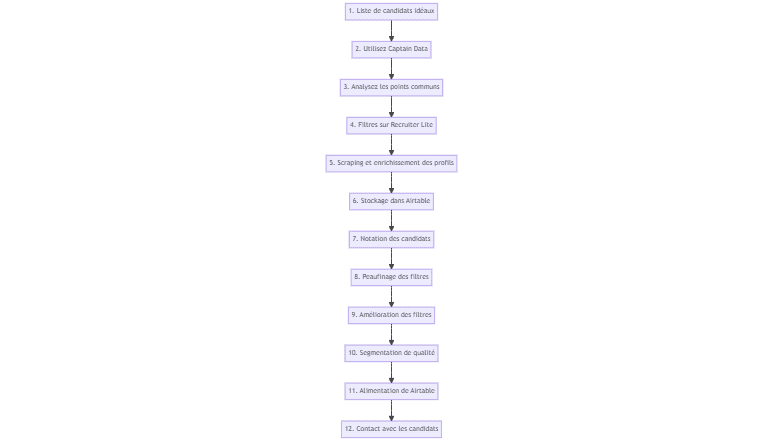How can you automate candidate sourcing?
Introduction
Candidate sourcing is a crucial step in finding the best talent. It’s a well-known fact: the most qualified candidates don’t always apply directly to a job offer, for a multitude of reasons (if you’re curious about these reasons, take a look at
this article
).
For any recruiter, sourcing candidates is vital but can be time-consuming and repetitive. Few professionals enjoy this task, hence the idea of making it more bearable through automation. So how can you automate your candidate search efficiently?
Traditional candidate sourcing methods
Before delving into the heart of the matter, let’s take a look at traditional methods of sourcing candidates, assessing their advantages, disadvantages and potential for automation.
- Jobboards: Welcome to the Jungle, Indeed, Pôle Emploi, Apec…
- Advantages: Candidates who contact you will normally have read the job description and already be interested in your offer.
- Disadvantages: The quality of CVs received can be quite low. Candidates often apply en masse to different companies, without necessarily looking to join yours in particular.
- Automatic: Yes
- Linkedin
- Benefits: Thanks to Linkedin filters and profiles, you can pre-qualify candidates before contacting them.
- Disadvantages: Can be time-consuming when done manually.
- Automatic: Yes
- Employer branding
- Advantage: This increases the number of unsolicited applications and makes candidates more interested in your company.
- Disadvantage: This is a time-consuming and costly process.
- Can be automated: No
- Co-option
- Advantage: Your colleague can vouch for the recommended person and give him or her an insight into everyday life at your company.
- Disadvantage: This method is rather risky, as your collaborators don’t have an infinite network of friends to recommend. To encourage your employees to coopt, it’s often necessary to set up a reward system.
- Can be automated: No
- Pool of candidates
- Advantage: This is often the first reflex of recruiters. The candidate has already been contacted and shown an interest in your company.
- Disadvantage: Few companies have a well-structured and up-to-date pool of candidates with an ATS.
- Automatic: Yes
There are solutions to automate the publication on different job boards, but for Stepward, this is not the most interesting option. Having tested it, our customers’ recruiters end up spending more time qualifying and sorting CVs than talking to candidates who are really suited to their vacancies.
That’s why we’re going to show you our method for automating sourcing via Linkedin. This is a more complex issue. If you are interested, you can make an appointment
here
.
Automated sourcing via Linkedin
To optimize sourcing via Linkedin, you’ll need Recruiter Lite or Sales Navigator. Here is our step-by-step method, using Recruiter Lite as a base:
- Make a manual list of ten or so people you think would be ideal candidates for the job.
- Use Captain Data to visit their profiles and get a Google sheet containing all their Linkedin profile information.
- Analyze the similarities between these profiles: type of company, experience, job title, skills, year of graduation, years of experience, etc.
- These commonalities will serve as your Recruiter Lite filters.
- Use Captain Data to scrape and enrich each profile.
- Store this information in an Airtable.
- Rate potential candidates from 1 to 5 stars, based on around 20 profiles.
- When analyzing profiles with less than 3 stars, fine-tune your filters to exclude certain characteristics.
- Thanks to profiles with between 3 and 5 stars, analyze recurrences and improve your filters.
- You start to get quality segmentation or specialized recruitment targeting.
- Feed your Airtable, which serves as a pre-ATS, with all scraped and enriched profiles. No need to write them down.
- All that’s left is to get in touch with all these potential candidates.

At Stepward, we rely mainly on Captain Data and Airtable for scraping. However, other tools are also available. In this article, I’ve prepared a comparison based on your budget and needs.
Now that you have several hundred lines in your Airtable and have made the effort to segment your candidates, it would be a shame not to automate the contact process. However, for 5-star candidates, I recommend contacting them manually with an ultra-personalized approach.
Contact automation
Automating contact is a three-step process:
- The choice of tool.
- Copywriting.
- Managing responses and structuring the pool.
At Stepward, we have chosen the following tools to automate our recruitment contacts:
- Lemlist or La Growth Machine: These tools enable you to contact us both on Linkedin and by email.
- N8N: It’s a complex tool, for which we’ve written an explanatory article.
- MirrorProfiles: This tool allows you to secure your pool of candidates and contact them quickly.
- MirrorChat: This tool centralizes Linkedin messaging. You can save template answers to save time. MirrorChat also has a webhook system to synchronize your ATS with your recruitment campaigns.
When it comes to copywriting, there are many different approaches, but there are some important rules to follow. I’ve written a full article on the subject.
You’ll need to work with your HR team to determine how much time they can devote to these recruitment campaigns each day. Reactivity is the key to a good campaign, so insist that this time is spent on a daily basis. If you get less than a 50% acceptance rate and a 45% response rate, then you’ll need to rework your copywriting. If you’d like us to take a look, please don’t hesitate to
make an appointment
.
Managing responses and structuring your ATS are two key factors in avoiding the “one-shot” effect. Management with MirrorChat will enable you to handle several dozen responses a day and generate first interviews for your recruiters. The advantage of this method is that it frees up time for these interviews, thanks to automation.
Conclusion
Automated candidate sourcing is a powerful lever for optimizing your recruitment process. It allows HR teams to spend less time on repetitive tasks and more time building meaningful relationships with potential candidates. The result is a richer candidate experience and improved quality of hire.
However, it’s important to remember that automation is not an end in itself. It’s a tool that, used wisely, can greatly improve your efficiency, but it’s no substitute for human judgment, dialogue and empathy. The best recruitment processes are those that combine the best of technology and humanity.
Ultimately, the aim is not just to find candidates, but to find the right candidates – people who can contribute to your company’s culture and help you achieve your business objectives. Automation can help you get there faster and more efficiently, but it’s the human approach that makes all the difference.
Don’t hesitate to contact us if you need help setting up your sourcing automation. At Stepward, we’re always ready to share our knowledge and help you succeed in your recruitment. Good luck in this wonderful adventure!





